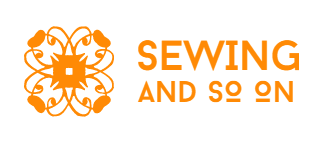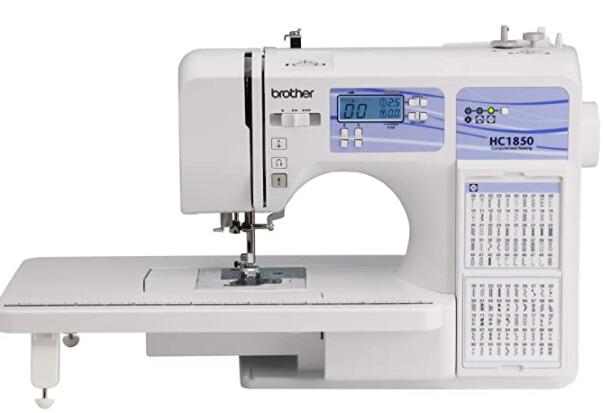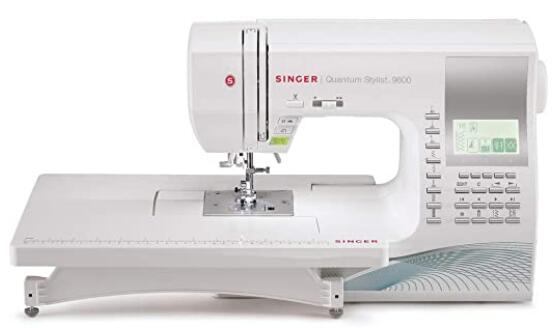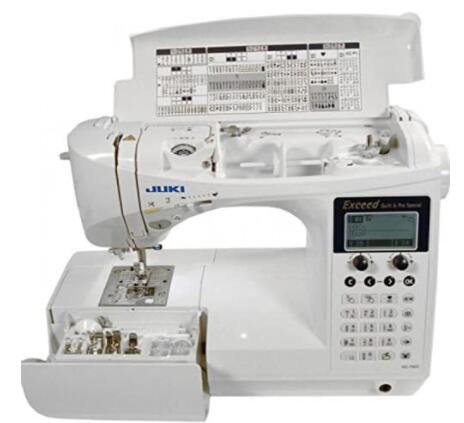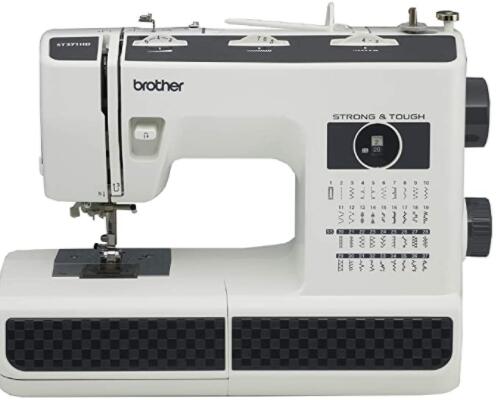Pushing a tiny needle up and down through multiple layers of thick fabric is hard to work. Also, lifting and feeding the material takes effort as well. It can be quite exhausting turning and moving the fabric.
But thankfully, there are modern sewing machines that are available to help you do the job. They make sewing more comfortable and give you an enjoyable sewing experience. These machines are automated for an easier time completing your sewing projects. They come with included accessories, so you have all you need to get started.
Moreover, these machines have functions and features that make them suitable for beginners and professionals alike. They come in a wide range of selection and brands. Here is a broader insight into these machines and some of the top-ranking models available in the market today.
Why Do You Need a Modern Sewing Machine?
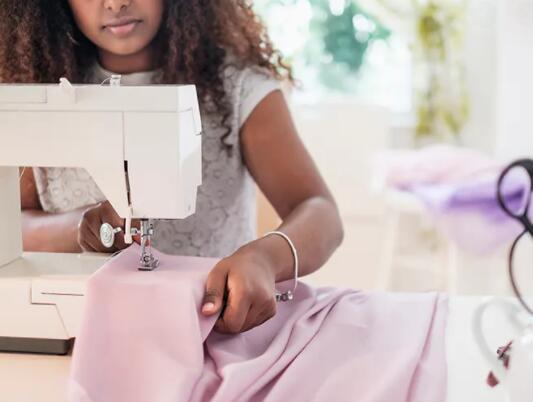
Modern sewing machines are very beneficial. Here are some of the reasons why you need one.
As clothes wear out, you can remake them. Nowadays, garments can wear out in just a year or two. You will have to find a way to make your clothes last longer. That is where the sewing machines come in handy. You can now take the old clothes apart and piece together the parts that are in good condition.
Easier to darn socks and other items that develop holes. Noticeably, modern socks tend to wear out faster than those made a few years ago. Darning socks that have designed holes has been made easier by these sewing machines. You will also notice that it is much easier for the device to patch small holes in other garments without using additional material to make the patch.
You can sew heavier and coarser fabrics. Denim garments and other heavy fabrics are hard to make, let alone repair by hand. Thankfully, these machines are handy to solve this issue and leave time for other tasks.
Make money as a seamstress or tailor. You can also use a modern sewing machine to generate some income for yourself. If you become proficient as a seamstress, you can make money now and even after a social collapse.
You can also use these machines to custom design clothes that will meet your needs. Another reason is that they allow you to get more out of any fabric that you come across and make blankets and quilts for many purposes.
Modern Sewing Machine Reviews
#1. Best For Professional – Brother HC1850 Sewing and Quilting Machine
Features:
- Large backlit LCD screen
- Built-in monogramming sewing font
- Lightweight and portable
- Adjustable sewing speed
- Wide table
You can never go wrong with the Brother HC1850 Sewing and Quilting Machine. This machine is sure to make sewing much more comfortable. It comes with 185 unique built-in stitches, which include decorative, utility, and quilting stitches. Moreover, this machine comes with a full lettering font as well as eight one-step buttonholes. You can also personalize your monograms with the 55 alphanumeric sewing stitches, including eight accented letters and ten symbols. This machine has incorporated features and functions that make it well suited for both beginners and advanced quilters. These functions include spring action quilting foot, free-motion quilting, and the detachable complete table.
On top of that, this machine features variable speed controls to suit different users. Also, start, stop, and reverse buttons that you can use to operate the machine efficiently. The free arm capability comes in handy when hemming pants, sleeves, and cuffs. Moreover, this machine comes inclusive of a complete table for your large projects. This computerized machine comes with an intuitive LCD screen that displays the recommended sewing foot, start and stop buttons, and adjustable sewing speed. It comes with a built-in automatic needle threader that makes threading easier and saves time. The drop-in bobbin system ensures that the bobbin stays in place and provides a reliable, even stitch quality. This machine is conveniently lightweight and comes with a handle for easy transportation.
Pros:
- This machine is incredibly lightweight and comes with a built-in carry handle that makes transportation easy.
- This machine is ideal for beginners, and professional quilters alike, with the 8 included sewing and quilting feet.
- It has a unique feed system that helps to move the fabric smoothly for more precisely formed stitches.
- The machine has an LED light to illuminate your workspace.
Cons:
- No cuff slot
#2. Best For Customing Projects – SINGER Quantum Stylist 9960 Computerized Portable Sewing Machine
Features:
- High speed
- 13 presser feet
- 600 built-in stitches
- Automatic 1-step buttonhole
- Top drop-in bobbin system
- Five stunning fonts
- Extension table
For those searching for a versatile modern sewing machine, the Singer Quantum Stylist 9960 Computerized Portable Sewing Machine is an exceptional choice. This machine is ideal for customizing projects, and it comes with a lot of easy to use features. You can count on it to fulfill your creative dreams with numerous built-in stitches such as decorative stitches, stretch, fundamental fashion sewing, crafting, home décor, and quilting. Moreover, there is a wide selection of fonts that you can use to personalize your projects. This machine comes with an automatic needle threader that spares you the hassle of having to thread on your own. This feature saves time, eliminates eye strain and frustration.
Another thing is, this machine comes with 600 built-in stitches, which includes 13 one-step buttonholes and five alphanumeric fonts. The buttonholes are equipped with an Exclusive Buttonhole Underplate. Furthermore, mirror imaging and stitch elongation provide even more creative possibilities. You can count on this machine to complete your projects quickly with the maximum sewing speed of 850 stitches per minute. This machine comes inclusive of some accessories to get you started, including a variety of presser feet. It is easy to use and is durable.
Pros:
- This machine has a maximum speed of 850 stitches per minute so that you can get done with your projects quickly.
- The automatic needle threader saves time and eliminates eye strain and frustration.
- It has two LED lights that illuminate your sewing surface for optimal viewing.
- There are 13 presser feet included for enhanced capability.
- It has a heavy-duty metal frame for long-lasting use.
- This machine is perfect for customizing projects.
Cons:
- Relatively heavyweight
#3. Best Easy to Use – Juki HZL-F600 Computerized Sewing and Quilting Machine
Features:
- Automatic needle threader
- Built-in stitches and patterns
- Industrial style buttonholes
- Variable speeds
- 2 LED lights
Juki HZL-F600 Computerized Sewing and Quilting Machine will exceed your expectations. This sewing machine comes with a wide selection of stitches and patterns that include decorative, alphabet, utility, four fonts, and 255 sewing patterns so you can personalize your projects. Moreover, it offers an open toe presser foot, edge sewing presser foot, and patchwork presser foot for different applications. Also, it has a large intuitive LCD screen that displays various selections and an easy pattern selection. This machine offers a comfortable, one-finger, automatic needle threader at a seating position. There is also an automatic thread trimming at the push of a button and an exclusive automatic line cutting by the foot pedal’s heel motion.
What’s more, this machine has variable speeds; the maximum sewing speed of 900 stitches per minute and a low sewing speed of 80 stitches per minute, so you can choose which one best suits you. Additional features such as walking foot come in handy for multiple sewing layers, including quilting and denim. Also, there is a durable quilting foot, quilt guide, precise and immediate needle stop, and precision feeding system. This machine is reliable, stable, and quiet. It comes with integrated LED lights that illuminate your works space for enhanced visibility. It is an excellent choice for beginners and professionals alike.
Pros:
- This machine is stable, reliable, and quiet.
- The two LED lights illuminate your workspace.
- The walking foot allows for multiple sewing layers.
- This machine comes with additional features.
- The large LCD screen is easy to read.
Cons:
- No extension table
#4. Best For Beginners – Brother ST371HD Sewing Machine with Automatic Thread
Features:
- One-step auto-size buttonhole
- Quick-set top drop-in bobbin
- Durable metal frame
- Metal needle plate
- 37 built-in stitches
- Built-in handle
Brother ST371HD Sewing Machine is a great machine and well worth the money. This durable and reliable mechanical machine comes with strong and tough features such as heavyweight needles and a metal needle plate. Thirty-seven unique built-in stitches include decorative, stretch, and zig-zag, as well as an auto-size buttonhole. Moreover, it features a top drop-in bobbin that is not only convenient but also jam-resistant. This machine makes threading easy every time thanks to the advanced needle threading function, which quickly pushes thread through the needle at the press of a lever.
Additionally, this sewing machine comes with a free arm that can be accessed by removing the accessory tray. The free arm makes sewing skinny jeans, sleeves, and cuffs a breeze. The heavyweight needle pack is suitable for heavyweight fabrics such as duck cloth, canvas, denim, sewing layers of cloth, and everyday sewing and lightweight materials. This machine includes accessories to get you started having six feet, four bobbins, a 3-piece needle set, and more. The nonstick foot helps improve the stitch quality and ensure consistent feeding for fabrics like suede, vinyl, leather, and hook& loop tape. The snap-on design allows you to switch between the sewing feet easily.
Pros:
- This machine also includes an instructional video and manual to get you started.
- The free arm makes it ideal for a wide range of simple sewing projects.
- It has a metal frame for durable sewing on various fabrics.
- The metal needle plate allows smoother fabric feeding.
- Storage is made easy with the built-in handle.
Cons:
- No extension table
Features of Modern Sewing Machine?
Sewing machines are machines used to sew materials and fabrics together with thread. Modern sewing machines are automated types of sewing machines. Therefore, the stitching process has been automated, so the fabric glides smoothly in and out of the devices. This machine is more convenient as it spares users the hassle of thimbles, needles, and other hand sewing tools.
Virtually, all modern sewing machines are electric– they are built around hefty electric motors. The electric motor is usually hidden inside the main stem. It works to drive three separate mechanisms that are timed carefully, so they cooperate. Two of the mechanisms are a mixture of cranks and cams and operate the feed dog. The other crankshaft driven by the motor makes the needle rise up and down. The final mechanism turns the shuttle and hook that is attached to it that makes the stitches.
How is Modern Sewing Machine Different?
The modern sewing machines differ from the traditional vintage models in various aspects. Here are some of them.
Features
New machines undoubtedly have more features than the vintage machines. For instance, some have advanced electronics and computer-controlled systems that enable them to do multiple fancy stitches. Also, the positions of the needle can be incrementally adjusted in a fraction of a millimeter.
Instead of touching a hand wheel or tapping the controller, modern machines can raise the needle at the touch of a button. These additional and convenient features, however, come at a price. They are also more complex to operate, unlike the vintage machines.
Durability and build quality
Quality vintage machines were made with higher quality components to ensure better overall build quality. They could easily outlast modern sewing machines. This is because the technology of computerized machines could get outdated and obsolete. Vintage machines, on the other hand, were built to last for generations. The new devices have a lifespan of 10 to 25 years at best, but the quality vintage machines will still be up and running.
Repair and maintenance costs
Modern machines usually have some parts and labor covered under warranty for some time. The terms of the warranties vary widely, and some dealers tend to charge a diagnostic fee to look at the machine. And once you get beyond the warranty coverage, some repairs can be very costly.
Also, most of the repairs are not DIY projects, and you are left with few alternatives. These new and modern machines may have lighter-duty components that can easily break if not taken care of. Maintenance cost with modern devices requires professional servicing.
The vintage machines, on the other hand, hardly had any warranties. Thankfully, they were well built and stood the test of time- significant repairs were unlikely. Also, regular maintenance could be quickly done by the owner without the need for a professional. It was a matter of removing dust, debris, and lint and lubricating the machine. However, you can still opt to take your device to the nearest local shop for thorough maintenance services.
Price and value
The vintage machines were very affordable. Sometimes you could find one at a throw-away price of $25. The condition, location, marketing, and market demand determined the selling price of these machines. New modern machines had higher price points ranging from $80 to about $10,000 and more. The higher-end machines costing thousands of dollars come with more complex features. They often require classes even to the professional sewist to operate them to their full potential.
The environmental and economic impact
The vast majority of modern sewing machines are made in Taiwan or China. Some high-end machines are assembled in Europe from the components manufactured in Asia. Therefore, purchasing a vintage machine over a new one was an economically and environmentally friendly choice. Many vintage machines were manufactured originally in the USA, so your money goes directly to the US economy.
Modern Sewing Machine Company
There is a list of reputed sewing machine brands and companies. The leading household manufacturers are Baby Lock, Bernina, Brother, Janome, Aisin Seiki, Juki, and SVP Worldwide.
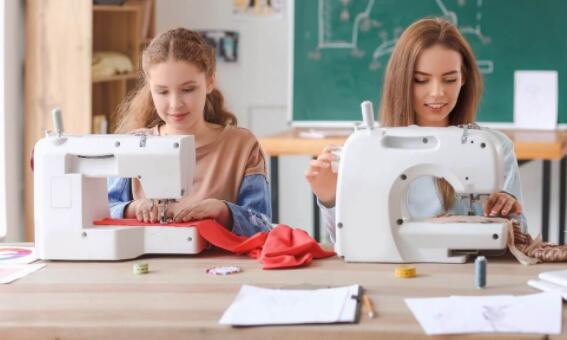
Bernina
Bernina international model 105 was the company’s first sewing machine. It was a privately owned global manufacturer of sewing and embroidery systems. Also, this company is based in Switzerland.
Brother
Brother Sewing Machines Company is based in Japan. It was established in 1908, and the first product marketed under the Brother brand was launched in 1928. It succeeded in the mass-production of home sewing machines in 1932.
Janome
Janome is a Swiss company that specializes in the mass production of sewing machines. It began its operations in the 1940s.
SVP Worldwide
SVP Worldwide is a private company that designs, manufactures, and distributes customer sewing machines and accessories under the following brands; Singer, VSM Group, and PFAFF Household.
How to Thread a Modern Home Sewing Machine?
It would be best if you learned how to thread a sewing machine properly. It is a simple yet daunting task for many. Below are a few steps you can follow.
- First, place the spool on the sewing machine. And then put the cap over the spool.
- Afterward, you should follow the numbers on your machine while guiding the thread through the tabs.
- Begin threading by bringing the thread through the first and second guides across the top of the machine.
- Then thread down in front of the sewing machine through guide three.
- Guide 4 will require you to thread back up the sewing machine.
- Once you reach the top again, bring the thread through the thread takeup on the sewing machine, bringing the line back down the machine.
What is a Modern Sewing Machine Made Of?
Modern sewing machines are made of various materials. The industrial models are made of cast iron for their frames and multiple materials for their fittings. Brass, steel, and other alloys make the specialized parts durable enough for long hours of factory conditions. However, when it comes to home sewing machines, lightweight housings are essential. These machines are known for their portability, versatility, and flexibility.
Most of the home machines have casings made of plastics or polymers that are light, easy to clean, easy to mold, and resistant to chipping and cracking. The frames of modern home machines are made of injection-molded aluminum, while other metals like nickel, copper, and chrome are used to plate specific parts. The home machines also require electric motors- a variety of precision-machined metal parts, including feed gears, hooks, cam mechanisms, needles, presser feet, and so on.
When Was the Modern Sewing Machine Invented, and Who Invented It?
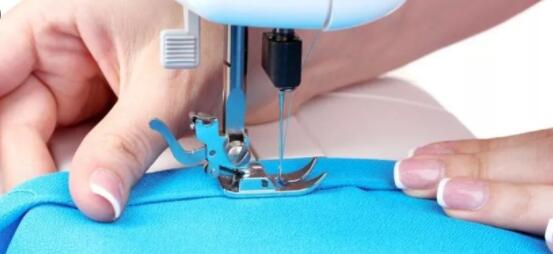
Like computers, airplanes, cars, and many other modern marvels, sewing machines cannot be credited to any single inventor. On one level, these machines simply automate from something ancient and fundamental- the idea behind them was joining textiles together with a piece of thread. Modern devices do so by using two separate threads that lock together. This idea was most probably inspired by the age-old process of weaving textiles with a loom, where one line passes back and forth through another at right angles.
These machines were mechanically based on an ingenious combination of wheels– very ancient inventions, with standard engineering components such as cranks, cams, and gears. Modern devices are powered using electricity- this was a 19th-century invention and their control and precision from electronics- a 20th-century development. These machines were less of an overnight design and more of gradual evolution. The electronic, mechanical, and electrical components were slowly automating to make the process of joining materials together less laborious, quicker, more precise, and more effective.
It has taken a concerted effort to make the modern machines what they are today. The journey started in 1589, where Englishman Willian Lee invented a simple frame for knitting wool stockings. Over the years was a series of modifications. Elias Howe received a patent for the first practical sewing machine in 1846. After years of experimenting with producing the first efficient sewing machine using two threads and a curved needle.
Unfortunately, it was too expensive in those days. In the subsequent years, many inventors worked on stitches such as the zig-zag stitch, overlocking, crochet stitch, hemstitch, etc. By 1933, the Singer company had developed the Featherweight, which was the first portable sewing machine. In 1978, they released a computer-controlled sewing machine. And today, we have a modern computerized sewing machine.
How Does a Modern-day Sewing Machine Work?
You may be interested to learn about the inner mechanisms of a modern sewing machine. There are so many moving parts packed into the small space making it difficult to figure it all out. It would be best to look at the mechanisms separately for better understanding. The electric motor rests at the bottom and the opposite end of the machine from the needle. Usually, the pulley arrangement drives the large handwheel at the top and main power shaft. Here are the three fundamental mechanisms.
Needle mechanism
The needle mechanism is the simplest of the three. The shaft is designed to drive a wheel and crankshaft, which makes the needle rise and fall. The crank converts the rotary motion of the motor into the needle’s reciprocal motion.
Bobbin and shuttle mechanism
The hook and shuttle that makes the stitches from the needle thread have to rotate faster than the needle. The shaft, therefore, turns the shuttle more quickly. It does so using gears or pulleys that are wrapped around the wheels of different sizes.
Feed-dog mechanism
The feed dog works to move the fabric through the machine faster to ensure the stitches are of equal length. It works by moving forwards and upwards simultaneously through two interlinked mechanisms driven off the main shaft. The wheel makes the lever rock back and forth, pulling the feed dog from right to left and then back again. At the same time, a second crank mechanism moves the feed dog up and down. When these two movements are synchronized, the feed dog works as a shoe at the end of an upside-down leg.
Conclusion
Computerized sewing machines offer automatic stitch settings, speed control, and other easy to use features. The models listed above are among the best in the market. They come with included accessories, so you can’t beat their value and quality. These machines are highly recommended for beginners and professionals alike. Do not hesitate to get one and explore your creative possibilities.
